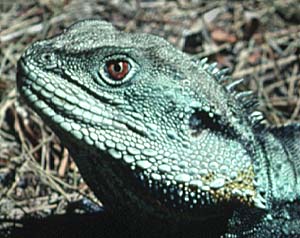![Director of National Parks [logo]](/images/dnp_90px.gif)


![Director of National Parks [logo]](/images/dnp_90px.gif) |
 |
 |
 What are Water Dragons ?
What are Water Dragons ? Identification: Water Dragons in Australia can be up to 1 metre, with long powerful legs and claws. Their tail forms 2/3 of their length and is almost all muscle. It is laterally compressed to help act like an oar when swimming. The Water Dragon has a nuchal crest – a central row of enlarged spikey spines at the back of the head. These spikes continue down the spine, decreasing in size to the base of the tail. At the tail the spines divide into two rows.
The Water Dragon’s upper body is a grey-green with cream and black transverse bands on the body and tail. Underneath the body is creamy brown-grey. They have loose folds of skin under the jaw, giving them an almost Bearded Dragon appearance.
Subspecies differences: The Eastern Water Dragon (Intellagama lesueurii lesueurii) has a dark stripe from ear to eye, that the Gippsland Water Dragon (Intellagama lesueurii howitti) lacks. The Eastern Water Dragon male has a red flush on its chest and darker bands. The Gippsland Water Dragon male has an olive-grey chest, and is distinguished with a colourful throat that is blotched or striped with various colours; orange, blue and yellow.
Sexual and age differences: Juvenile Water Dragons are light brown in colour, with head and feet disproportionately large compared with the adults. The female Water Dragons lack the bright colourations on the chest and throat, and have narrower, more delicate heads. The male Water Dragon’s head is much larger and angular.
|
 Swimming: Water Dragons as their name suggests are semi-aquatic lizards. They spend a lot of time perching in trees along creeks and rivers. At any sign of danger they will dive into the water and either remain underwater or swim away. Water Dragons have been known to remain underwater for up to 90 minutes. Water Dragons when underwater slow their heart rate and conduct some gas exchange across their skin, both O2 and CO2.
Swimming: Water Dragons as their name suggests are semi-aquatic lizards. They spend a lot of time perching in trees along creeks and rivers. At any sign of danger they will dive into the water and either remain underwater or swim away. Water Dragons have been known to remain underwater for up to 90 minutes. Water Dragons when underwater slow their heart rate and conduct some gas exchange across their skin, both O2 and CO2.
Running: Water Dragons at slow speeds run on all four legs, but to increase their running speed they can run on their back legs only (bipedally). Their long powerful back legs and sharp claws help in their abilities to climb trees and dig holes for hibernation and nesting.
Eating: Water Dragons are omnivorous (eat both plant and animal matter). They generally feed on insects, frogs, yabbies, other aquatic organisms, fruits, berries and flowers. They can eat under water. There has been recorded incidents of cannibalism occurring to young hatchlings.
When to see them at the Australian National Botanic Gardens
Text prepared by Robyn Lawrence (2006) as part of a Master of Science (specialising in science communication) at the Australian National University.
|
Claire Gorman, from ABC Canberra Radio 666, interviewed University of Canberra’s Sean Doody, from the Applied Ecology Research Group, on 4 November 2004, about his work on the Botanic Gardens' Water Dragons. To hear the interview from ABC (streaming audio) click here. Claire's interview (Dur: 6 min 13 sec) or as MP3 (1,123 KB) |